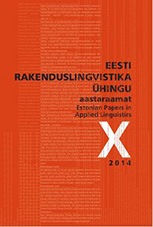Ilukirjanduskeelest uue pilguga
ON BELLETRISTIC LANGUAGE FROM A NEW PERSPECTIVE
Author(s): Jekaterina Trainis, Kais AllkiviSubject(s): Language and Literature Studies
Published by: Eesti Rakenduslingvistika Ühing (ERÜ)
Keywords: belletristic language; cluster analysis; morphosyntactic variability; lexical variability; Estonian
Summary/Abstract: The article describes the usage patterns of the Estonian belletristic language, which indicate how native speakers prefer to express their thoughts in writing. Research material is taken from the syntactically analyzed and disambiguated corpus of Estonian literary language. Cluster analysis that has been applied brings forth identical linear subsequences of morphological and syntactic tags based on frequency. Morphosyntactic trigrams that appeared in the corpus at least twice have been selected for the analysis. The patterns of language use have been presented on the basis of the lexical category of the first component of constructions. Every morphological class consists of subclasses that have a common beginning and ending component, and every subclass consists of clusters that are distinguished by the variation of the middle components of trigrams. A cluster contains trigrams that have the same subsequence of morphological and syntactic tags. This hierarchy reveals general tendencies of language use as well as the limits of morphosyntactic and lexical variability.
Journal: Eesti Rakenduslingvistika Ühingu aastaraamat
- Issue Year: 2014
- Issue No: 10
- Page Range: 283-306
- Page Count: 24
- Language: Estonian

